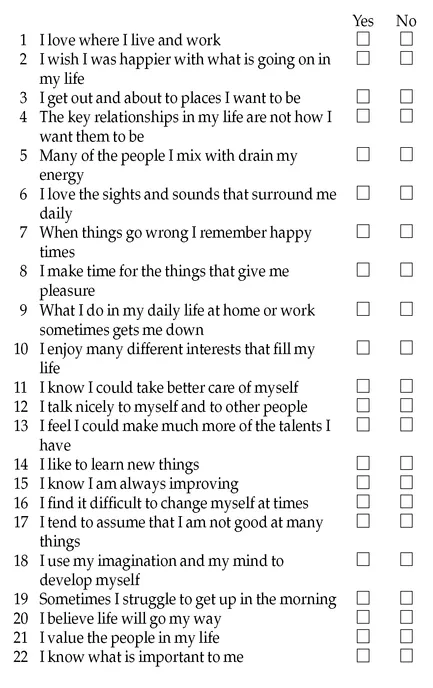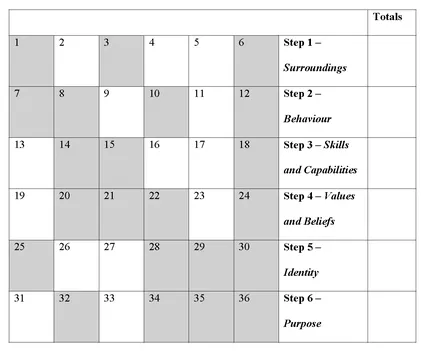![]()
1
The Happiness Questionnaire
How happy can you be? Before you can take any steps to increase your happiness, it’s best to check how happy you are right now.
We may or may not be born with a natural flair for happiness, but everyone can make or increase their own happiness in different parts of their life. It is simply a question of knowing how. Fill in the questionnaire below before you read the book and discover how truly happy you think you are.
When filling in this questionnaire, first of all remember that there are no right or wrong answers, with nothing bad or good about any score. Use the results to decide how you are going to read the book. Remember that this will be a reflection of how you are choosing to be at this particular moment in time. You can change if you want to and if you are willing to learn how to change.
You can also do this Happiness Questionnaire on our website www.switchtosuccess.co.uk. If you take the time to do that as well, then you will receive by e-mail an individually tailored Happiness Profile.
Overleaf you will find 36 statements. Read each statement carefully and decide whether you agree with it more than you disagree.
If you mainly agree, tick YES.
If you mainly disagree, tick NO.
Answer every question and remember that although some answers may be harder to find than others, the more honest you are, the more valid the results will be.
Don’t spend too long over any one question. If you are undecided, it’s important to put down the first answer that popped into your mind.
The Stairway of Happiness Scoring Grid
1. Transfer every answer (Yes or No) into the relevant box in the Scoring Grid below
2. Circle every Yes answer you have that appears in a shaded box
3. Circle every No answer you have that appears in a clear box
4. Each circle is worth one point, so add up the number of circles in each row to get your totals
Remember! For a more in-depth and personally tailored Happiness profile why not complete the Happiness questionnaire online? Visit www.switchtosuccess.co.uk
In order to understand your scores, check out the Stairway of Happiness below, then go on to read how to interpret your scores.
The Stairway of Happiness
Interpreting your scores on the Stairway of Happiness
Each row on the Scoring Grid represents one of the Steps on the Stairway of Happiness. The person who is truly happy is someone who sustains a high score at every level.
When you look at the scores you will see that the maximum score on any of the Steps is 6. If you have scored 4 or more, it would indicate that you are reasonably happy at that level. However, a score of 3 or less could mean that you have a certain dissatisfaction in that area of your life.
In order to improve the amount of happiness in your life, begin by reading the full description of each of the Steps on the Stairway of Happiness. First of all focus on all the parts of your life that bring you happiness. It is important to keep these in mind and to appreciate them before focusing on those areas where you have the lowest score. Now you can begin your journey of exploration. Remember that how you feel today about your happiness may differ from what you felt last week or what you may feel next week. Use the techniques and the Brilliant Ideas in each chapter of The Book of Happiness to make that state more permanent.
The Stairway of Happiness
Step 1 - Surroundings
Your Surroundings are everything you see, hear and feel when you look around you. This includes your physical environment at home and at work. It’s the places that you visit regularly, the weather and the climate you live in. It’s the places you don’t visit, the places you don’t go and the things that you don’t have as well as the things you do. It’s what you see when you look out of your window, it’s what you hear, whether it’s a bird song or traffic noise. It’s what you listen to by choice and what you are forced to listen to. It can be the music you hear or television programmes you watch. It’s also about the sort of relationships that surround you and your general health. All these aspects of our environment are the building blocks for our happiness.
Step 2 - Behaviour
What we mean by Behaviour includes what you do, how you do it, who you do it with and how others behave with you. It’s also about what you say and how you say it. It’s about the recognition that what you do and what you say has an impact on how happy you feel. This is not only what you say out loud to others but it’s your internal voice whispering in your ear. Behaviour is about choice. It’s about taking responsibility for your own actions and the way you respond to the situations that you have to deal with every day in life. This includes your attitude and your emotional responses. It’s whether you tap into your good memories or focus on the bad things that have happened in the past.
Step 3 - Skills and Capabilities
Skills and Capabilities cover a very wide range. This is not just about examination success, formal qualifications or certificates, badges or medals that prove your worth. It includes a huge range of skills which you are capable of growing if you put your mind to it or if you have the opportunity. It is how you manage your emotions and your behaviours. Some skills come naturally and others need working at. It encompasses how you manage your physical well-being and health, ensuring you are in the best possible state to make the most of your natural gifts. By growing your gifts, you grow the happiness habit.
Step 4 - Values and Beliefs
Values and Beliefs are the programming, the power and the motivation for what we do in our daily lives. They provide the energy and the drive and the passion behind our actions. Our values are the things that are important to us. This can include things such as harmony, security, health, freedom, honesty, trust, family, generosity, openness, cleanliness, orderliness, organisation, variety, impulsiveness, options - the list is endless and it’s also personal. Beliefs are our truths. They can be our guidelines, our rules or our justification for the things we do. Living life in line with our values is essential for happiness.
Step 5 - Identity
As a happy person you will know yourself inside and out and accept who you are. You will know your strengths and also the areas that let you down.
Being able to be yourself springs from a certainty and an acceptance about the essence of you. Your Identity is not affected by the labels other people might want to attach to you. Part of who you are lies in your roots - your name, your country, your genes, your upbringing, your loyalties, your country of origin, your faith, the colour of your skin. But it’s also about recognising that you are more than that. It’s an acceptance that there are many things about yourself that you can’t change, and an acknowledgement that you do not have to be imprisoned by them. You can make the most of who you are. The key to being comfortable about your Identity is recognising the qualities you have within you that make you different and unique.
Step 6 - Purpose
Purpose is what brings meaning into your life and the recognition that you are part of a larger whole. It answers the big life question ‘Why am I here?’ Some people are born with a conviction about the sort of vocation they would like to follow. They have a calling in life and this gives them a personal life map that provides them with a strong direction. If you have a clear sense of Purpose, you are likely to be happy and to integrate successfully your dreams into your life. Those who lack Purpose can find they are restless, aimless or feel dissatisfied with their lives.
![]()
2
The Stairway of Happiness
‘And they all lived happily ever after.’ The end of the fairy tale is the beginning of life and this is where we are picking up the tale. A fairy tale assumes that happiness is an automatic follow on and an automatic right. Undiluted happiness in a cloudless sky with none of the problems of everyday life to cast a shadow - that’s the world of fairy tales.
The fairy-tale version of happiness does not match reality as most of us know it. Happiness comes and goes; sometimes it is more intense than others. Unhappiness can overshadow your life and it can infiltrate all areas. It can prevent you from experiencing pleasure. For example, if you are unhappy you are unlikely to appreciate many of the little things that would normally brighten your day such as the sun shining, or a special meal, the flowers in the window box, music on the radio, the company of a good friend. What is making you unhappy overshadows everything else in your life. It gains a momentum and an importance that is often disproportionate. Sadness is different to unhappiness. Sadness is part of life and we experience it as a result of difficult life events such as bereavement.
If only we had a formula for happiness we could increase our level of happiness and decrease our level of unhappiness.
How would it be if you could have more control over how happy you are day to day, week to week, month to month and year to year?
This book is the best investment of your life but only if you follow our formula for it and commit to the actions we suggest. It takes 21 days to change a habit so think how happy ...






